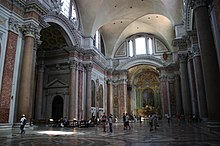Materials

Stoneedit
Marble is not found especially close to Rome, and was only rarely used there before Augustus, who famously boasted that he had found Rome made of brick and left it made of marble, though this was mainly as a facing for brick or concrete. The Temple of Hercules Victor of the late 2nd century BC is the earliest surviving exception in Rome. From Augustus' reign the quarries at Carrara were extensively developed for the capital, and other sources around the empire exploited, especially the prestigious Greek marbles like Parian. Travertine limestone was found much closer, around Tivoli, and was used from the end of the Republic; the Colosseum is mainly built of this stone, which has good load-bearing capacity, with a brick core. Other more or less local stones were used around the empire.
The Romans were extremely fond of luxury imported coloured marbles with fancy veining, and the interiors of the most important buildings were very often faced with slabs of these, which have usually now been removed even where the building survives. Imports from Greece for this purpose began in the 2nd century BC.
Roman brickedit
The Romans made fired clay bricks from about the beginning of the Empire, replacing earlier sun-dried mud-brick. Roman brick was almost invariably of a lesser height than modern brick, but was made in a variety of different shapes and sizes. Shapes included square, rectangular, triangular and round, and the largest bricks found have measured over three feet in length. Ancient Roman bricks had a general size of 1½ Roman feet by 1 Roman foot, but common variations up to 15 inches existed. Other brick sizes in ancient Rome included 24" x 12" x 4", and 15" x 8" x 10". Ancient Roman bricks found in France measured 8" x 8" x 3". The Constantine Basilica in Trier is constructed from Roman bricks 15" square by 1½" thick. There is often little obvious difference (particularly when only fragments survive) between Roman bricks used for walls on the one hand, and tiles used for roofing or flooring on the other, so archaeologists sometimes prefer to employ the generic term ceramic building material (or CBM).
The Romans perfected brick-making during the first century of their empire and used it ubiquitously, in public and private construction alike. The Romans took their brickmaking skills everywhere they went, introducing the craft to the local populations. The Roman legions, which operated their own kilns, introduced bricks to many parts of the empire; bricks are often stamped with the mark of the legion that supervised their production. The use of bricks in southern and western Germany, for example, can be traced back to traditions already described by the Roman architect Vitruvius. In the British Isles, the introduction of Roman brick by the ancient Romans was followed by a 600–700 year gap in major brick production.
Roman concreteedit
Concrete quickly supplanted brick as the primary building material,citation needed and more daring buildings soon followed, with great pillars supporting broad arches and domes rather than dense lines of columns suspending flat architraves. The freedom of concrete also inspired the colonnade screen, a row of purely decorative columns in front of a load-bearing wall. In smaller-scale architecture, concrete's strength freed the floor plan from rectangular cells to a more free-flowing environment.citation needed Most of these developments are described by Vitruvius, writing in the first century BC in his work De architectura.
Although concrete had been used on a minor scale in Mesopotamia, Roman architects perfected Roman concrete and used it in buildings where it could stand on its own and support a great deal of weight. The first use of concrete by the Romans was in the town of Cosa sometime after 273 BC. Ancient Roman concrete was a mixture of lime mortar, aggregate, pozzolana, water, and stones, and was stronger than previously-used concretes. The ancient builders placed these ingredients in wooden frames where they hardened and bonded to a facing of stones or (more frequently) bricks. The aggregates used were often much larger than in modern concrete, amounting to rubble.
When the framework was removed, the new wall was very strong, with a rough surface of bricks or stones. This surface could be smoothed and faced with an attractive stucco or thin panels of marble or other coloured stones called a "revetment". Concrete construction proved to be more flexible and less costly than building solid stone buildings. The materials were readily available and not difficult to transport. The wooden frames could be used more than once, allowing builders to work quickly and efficiently. Concrete is arguably the Roman contribution most relevant to modern architecture.
Comments
Post a Comment